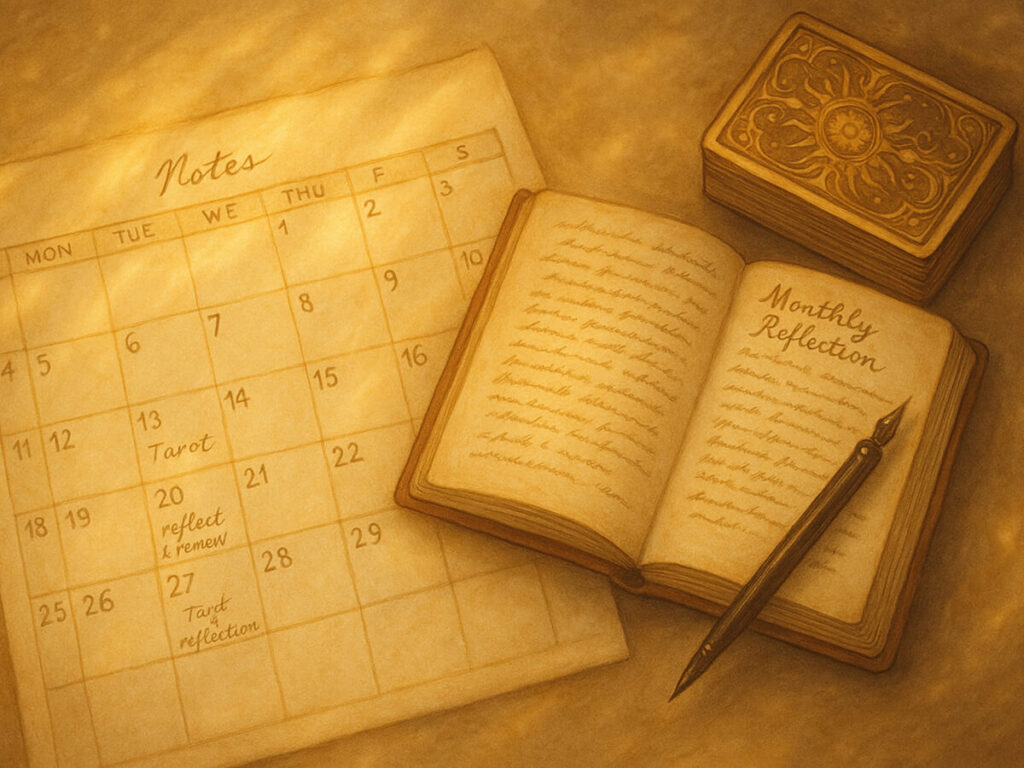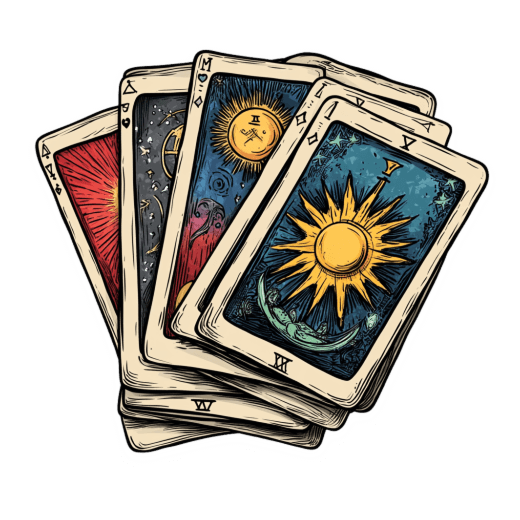How to Create a Monthly Self-Reflection Routine with Tarot


Table of Contents
Have you ever felt like life is moving so fast that you can’t catch your breath? I certainly have! Back in 2010, I was juggling a demanding career, family obligations, and barely had time for myself. That’s when I stumbled upon monthly tarot self-reflection, and it changed everything.
According to a 2024 study published in the Journal of Mindfulness Practice, regular reflection rituals like monthly tarot practices can reduce stress by up to 37% and improve decision-making clarity. These aren’t just mystical claims; they’re backed by psychological research showing how structured symbolic reflection creates mental space for processing experiences.
My journey with monthly tarot reflection began somewhat accidentally. I’d received a beautiful deck as a gift and decided to set aside just one evening each month to check in with myself. What started as a casual practice evolved into a profound tool for personal growth that I’ve maintained for over 15 years.
This guide isn’t about fortune-telling or predicting the future. Instead, I’ll walk you through how to create a meaningful monthly practice that helps you connect with your inner wisdom, track your personal growth, and make more aligned decisions. Whether you’re a complete beginner or have been working with tarot for years, you’ll find practical techniques to deepen your practice.
Understanding the Power of Monthly Tarot Self Reflection
I remember the first time I tried monthly tarot reflection instead of my usual daily pulls. It was like switching from a flashlight to floodlights! The broader perspective completely transformed how I understood myself.
Monthly tarot self-reflection works differently than occasional readings or daily card pulls. Where daily cards give you snapshots, monthly reflection offers panoramic views of your life’s landscape. It’s like the difference between checking weather updates versus studying seasonal patterns. Both are valuable, but they serve different purposes.
The psychological benefits are significant. Dr. Elena Ravenstein, clinical psychologist and author of “Symbols and the Self,” found that “regular engagement with symbolic systems like tarot creates cognitive frameworks that help individuals process complex emotions and experiences.” I’ve experienced this firsthand! When I was struggling with a career transition in 2018, my monthly reflections helped me identify patterns of fear that daily readings had missed entirely.
There’s something almost magical about how monthly cycles align with our natural rhythms. In traditional wisdom traditions, moon cycles were considered powerful times for reflection, and modern research supports this intuitive knowledge. Our bodies and minds naturally operate in cycles, making monthly intervals ideal for meaningful self-assessment.
What makes this practice particularly powerful is its accumulative effect. I’ve kept my monthly reflection journals for years now, and sometimes I’ll look back and notice themes that developed over 6-8 months that I completely missed in the moment. One year, the Hanged Man appeared in five consecutive monthly readings before a major perspective shift occurred in my life. This was something I might have overlooked without the monthly documentation.
The structured nature of monthly practice also builds a different relationship with your intuition. Instead of reaching for cards whenever you feel anxious (which can sometimes reinforce anxiety), you create a contained space for deeper listening. This has helped me develop more trust in my own inner guidance between readings.
For practical purposes, I’ve found monthly reflection pairs beautifully with goal-setting practices. My friend Sarah uses hers at month-end to evaluate progress and reset priorities, while I prefer new moon timing to align with fresh starts. There’s no single “right” timing. The power lies in the consistency and intention you bring.
If you’re new to tarot, don’t worry about getting everything “perfect.” The beauty of monthly practice is how it evolves over time. I still laugh at my early interpretations compared to the nuance I see now. The journey itself is where the wisdom emerges.
Creating Your Sacred Monthly Tarot Ritual Space
The first time I tried doing a monthly tarot reading at my cluttered kitchen table, surrounded by bills and grocery lists, I couldn’t focus to save my life! Trust me, where and how you practice makes all the difference.
Creating a dedicated space doesn’t mean you need an entire room, just a consistent area that signals to your brain “this is reflection time.” I started with just a corner of my bedroom with a small side table. Now I have a fold-up altar table that I only set up for my monthly practice. The physical act of setting it up has become part of my ritual, helping me transition from everyday thinking to reflective mindset.
The energy clearing aspect is something I initially dismissed as too “woo-woo,” but I’ve found it genuinely helps. Before beginning, I take a moment to tidy my space, light a candle, and sometimes use a bit of lavender essential oil in a diffuser. These simple acts help clear mental clutter as much as physical space. According to research published in Environmental Psychology Quarterly, even small environmental rituals can trigger state-dependent memory, making it easier to enter contemplative states.
As for essential tools, keep it simple at first. You’ll need:
- Your chosen tarot deck (I rotate between three that resonate differently)
- A journal dedicated to your monthly reflections
- Something to write with (I prefer colored pens for coding emotions)
- Optional: a cloth to lay your cards on
- Optional: a candle, incense, or crystals if they help you focus
I’ve seen beautiful elaborate setups on social media that made me feel inadequate until I realized that simplicity often leads to deeper practice. My most profound insights have come from the most basic settings when my focus was on presence, not perfection.
The timing of your practice matters too. I’ve experimented with different schedules and found that consistency trumps perfect timing. That said, I’ve found evening sessions more fruitful than morning ones. My mind is more receptive when the day’s demands are behind me. Some practitioners swear by moon phases, while others align with calendar months. After years of practice, I’ve settled on the last Sunday evening of each month, which gives me time to integrate insights before the new month begins.
Temperature, lighting, and sound all contribute to creating the right atmosphere. I prefer soft, warm lighting rather than harsh overheads, and either complete silence or gentle instrumental music without lyrics. I’ve accidentally discovered that slightly cooler room temperatures keep me alert but comfortable during longer reflection sessions.
Remember that your space will evolve with your practice. What works in your first few months might change as you deepen your relationship with tarot. Listen to what your mind and body need to feel both safe and open to insight. Your sacred space is ultimately about creating conditions where your inner wisdom can speak clearly.
Selecting Powerful Tarot Spreads for Monthly Self-Assessment
When I first started monthly reflections, I tried using the same complex 15-card spread I’d found in an advanced tarot book. Big mistake! I ended up confused and overwhelmed. Through years of trial and error, I’ve learned that the right spread makes all the difference.
For monthly self-reflection, I’ve found that spreads with 3-7 cards offer the sweet spot between depth and clarity. They provide enough information to be meaningful without becoming overwhelming. Let me share some spreads that have served me well over the years:
The Monthly Compass Spread (4 cards)
- Where I am now (current energy)
- What’s supporting me this month
- What’s challenging me this month
- Guidance for my highest good
This straightforward spread gives you a clear orientation and has been my go-to for beginners. I used this exclusively for my first year and still return to it when life feels particularly chaotic.
The Growth Spiral (5 cards)
- Lesson from last month
- Energy entering this month
- Opportunity for growth
- Potential blind spot
- How to integrate all aspects
I developed this spread during a particularly transformative period in my life. It excels at connecting your journey across months, helping you see your growth as a continuous process rather than isolated experiences.
The Elements Check-In (5 cards)
- Earth: Physical wellbeing and resources
- Air: Mental clarity and communication
- Fire: Passion, creativity, and motivation
- Water: Emotional landscape and intuition
- Spirit: Higher purpose and alignment
This spread has been particularly helpful during times when I felt out of balance. It clearly shows which elements in your life need more attention and which are flourishing.
For tracking progression across months, I recommend creating a simple system in your journal. I use color-coding to mark recurring cards and themes, which has revealed fascinating patterns over time. One year, I noticed the Strength card appeared in my “challenge” position for three consecutive months before I finally addressed a difficult relationship situation.
Don’t be afraid to modify classic spreads to suit your needs. When I felt stuck in a career transition, I added a “hidden opportunity” position to my monthly spread, which consistently revealed resources I was overlooking. Your intuition knows what you need. Trust it to guide your spread selection or creation.
For beginners, I suggest starting with the Monthly Compass and sticking with it for at least three months before trying something new. This consistency will help you develop confidence in your interpretation skills and establish a baseline for your personal card meanings.
Remember that the most effective spread isn’t necessarily the most complex one. The best spread is one that asks the right questions for your current life circumstances and level of tarot experience. As your practice deepens, your spreads will naturally evolve alongside your understanding.
Journaling Techniques to Deepen Your Monthly Tarot Practice
I still have my first tarot journal, a simple composition notebook with awkward interpretations and uncertain notes. Looking at it now makes me smile because I can see how far my practice has evolved. Effective journaling doesn’t happen overnight, but it’s absolutely transformative for your tarot practice.
The most powerful journaling technique I’ve discovered is pairing specific prompts with your card readings. Instead of just recording what cards appeared, try these deeper inquiries:
- How does this card make me feel physically? (Notice sensations in your body)
- What memory or situation does this card bring to mind?
- If this card could speak directly to me, what would it say?
- How might the opposite interpretation of this card also be true for me?
These questions transform basic card meanings into personalized wisdom. When the Tower appeared in my reading during what seemed like a perfectly stable month, the prompt “Where might I be resisting necessary change?” helped me identify an unhealthy relationship pattern I’d been ignoring.
Tracking patterns across months has been particularly revealing. I create simple charts at the back of my journal noting which suits, numbers, and archetypes appear most frequently. During one six-month period, I noticed an abundance of Pentacles, which perfectly coincided with a time when I was overly focused on material security at the expense of emotional connections.
For visual thinkers, integrating artistic expression can unlock deeper understanding. I’m not particularly artistic, but even my simple color associations and doodles have enhanced my practice. One month, I spontaneously sketched a bird cage around the Eight of Swords, which helped me recognize how I was imprisoning myself with negative thought patterns.
Some practical organization tips I’ve found helpful:
- Date each entry and note any significant events or moon phases
- Leave space after your initial interpretation to add insights that emerge days later
- Take photos of particularly significant spreads
- Create quarterly summary pages to identify longer patterns
- Include a “synchronicity” section to note real-life events that seem connected to your readings
The most transformative journaling practice I’ve developed is a monthly dialogue between my present and future self. After recording my reading, I write a letter to my future self about my current challenges, hopes, and questions. The following month, I respond to that letter before doing my new reading. This creates a powerful conversation across time that has provided extraordinary insights.
When I first started, I worried about “doing it wrong” or having nothing significant to write. If you feel that way, just start with simple observations and let your practice evolve naturally. Some of my most profound entries began with “I’m not sure what this means, but…”
Your journal becomes more valuable over time. I recently reviewed entries from three years ago and discovered patterns I couldn’t possibly have noticed in the moment. This long-view perspective is perhaps the greatest gift of combining monthly tarot practice with dedicated journaling.
Aligning Monthly Tarot Practice with Moon Phases
I’ll be honest. I initially thought connecting tarot with moon phases was just mystical fluff until I experimented with it myself. The difference in the quality of my readings was so noticeable that it’s now a core part of my practice.
The moon’s 29.5-day cycle creates a natural rhythm that parallels our own internal cycles. Research in chronobiology suggests that humans are affected by lunar cycles in subtle but measurable ways, influencing everything from sleep quality to emotional sensitivity. I’ve found that aligning my tarot practice with these natural rhythms enhances my intuitive connection.
The New Moon phase brings powerful energy for intention-setting and new beginnings. When I conduct readings during this phase (usually within 3 days of the astronomical new moon), I focus on questions like: “What is emerging in my life?” and “What seeds am I planting for the future?” The cards often reveal subtle energies that aren’t yet visible in my everyday experience. My New Moon spread is simpler, usually 3-5 cards, focusing on potential and direction.
Full Moon energy feels completely different, more illuminating and revealing. During full moon phases, hidden aspects often come to light. My readings during this time tend to focus on questions like: “What is being revealed to me now?” and “What completion or culmination am I experiencing?” I’ve had some of my most profound shadow work insights during full moon readings.
The Quarter Moons (First and Last Quarters) provide excellent checkpoints for adjustment and evaluation. I use these phases for shorter readings that help me course-correct and work through obstacles that have emerged since my main monthly reading.
Practically speaking, I maintain a lunar calendar specifically for planning my tarot practice. I don’t always manage to align perfectly with the exact astronomical timing, but I try to stay within a 2-3 day window. If you’re just starting out, I recommend experimenting with New Moon readings for setting monthly intentions and Full Moon readings for reflection and illumination.
For those who track menstrual cycles, there can be fascinating correlations between your personal cycle and moon phases that add another layer to your readings. I’ve noticed that readings during certain combinations of moon phases and my personal cycle tend to focus on specific life areas with remarkable consistency.
One technique I’ve found particularly powerful is incorporating moon symbolism into my interpretations. For example, cards with water imagery take on additional significance during Cancer or Pisces moons, while fire symbolism feels more potent during Aries or Leo moons.
The moon’s influence on tarot isn’t about mystical superstition. It’s about working with natural cycles that have guided human experience for millennia. As astrologer and tarot practitioner Celeste Woodward notes, “The moon phases create energetic doorways that, when utilized consciously, can deepen our access to intuitive wisdom.”
Whether you embrace the lunar connection fully or simply use it as another tool in your practice, paying attention to these natural cycles adds a rich dimension to monthly tarot reflection.
Connecting Past, Present and Future Through Monthly Readings
When I look back at my tarot journals from five years ago, I’m amazed at how clearly they mapped the journey I was about to take, though I couldn’t see it at the time. Monthly readings become truly powerful when you connect them across time, creating a narrative of your personal evolution.
The method that’s worked best for me is creating quarterly synthesis readings. After three months of regular practice, I review all three readings together and do a special “integration spread” that helps me see the bigger picture. This has revealed astonishing patterns that were invisible when looking at each month in isolation. During one particularly challenging year, I noticed the Hanged Man appeared in different positions across four consecutive months. This perfectly tracked my resistance, surrender, and eventually, transformation around a major life change.
To effectively compare readings across consecutive months, I developed a simple system:
- I photograph each spread and keep them in a dedicated digital album
- I maintain a card tracking sheet, noting which cards appear repeatedly
- I color-code themes that emerge across readings (relationships, career, spiritual growth, etc.)
- I write “thread questions” that carry forward from one month to the next
Growth patterns often emerge in fascinating ways. I’ve noticed that challenging cards frequently appear in a sequence. First in a future position, then as a present challenge, and finally as a past lesson. This progression helps me track how I’m processing life experiences through different stages. For instance, the Tower appeared in my “future” position the month before a job loss, showed up in my “present challenge” during the actual transition, and then appeared in my “lesson from the past” position once I’d found an even better opportunity.
For continuous development, I use a technique I call “dialogue across time.” At the end of each monthly session, I write a specific question for my future self based on the current reading. The following month, I begin by answering that question before conducting my new reading. This creates a meaningful conversation with myself that builds continuity and deeper insight.
Annual reviews have become a cherished ritual for me. Every December, I spread out all twelve monthly readings and look for the year’s overarching story. I create a special “year in review” spread that helps me honor the journey and extract the most significant lessons. Last year, I was stunned to see how a subtle theme of creative rebirth had woven through my readings long before I consciously embraced a new artistic practice.
The most unexpected benefit of this long-view approach has been developing trust in my own process. When challenging cards appear, I no longer react with fear because I’ve seen how difficulties transform into growth over time. As tarot teacher Julia Ingram writes, “The cards don’t predict a fixed future, they reveal the energetic weather patterns moving through your life.”
By connecting your readings across time, you develop a profound trust in your life’s unfolding story and your capacity to navigate it with wisdom.
Overcoming Common Challenges in Monthly Tarot Practice
I still remember the month I almost abandoned my tarot practice altogether. After drawing the Tower, Death, and Ten of Swords in a single reading, I slammed my journal shut and didn’t want to look at my cards for weeks! Working through that resistance taught me valuable lessons about facing challenging aspects of self-reflection.
Resistance is perhaps the most common obstacle in maintaining a monthly practice. Some months you might find yourself “too busy” or “forgetting” your session. In my experience, this usually happens when subconsciously you’re avoiding something important. When I notice resistance arising, I now take a gentler approach. Perhaps doing a simpler spread or focusing specifically on what I’m avoiding and why.
Fear often emerges when difficult cards appear. Many beginners panic at cards like Death, the Tower, or the Three of Swords. I’ve learned that these challenging cards are usually the most important messengers. During a period of career uncertainty, I dreaded seeing the Eight of Cups in multiple readings until I finally acknowledged I needed to leave a prestigious but unfulfilling position. The relief that followed was immense.
For interpreting difficult cards, I’ve developed a three-question approach:
- What necessary ending or change might this card be pointing toward?
- What would become possible if I embraced this energy rather than resisted it?
- What is the most compassionate way to work with this challenge?
Maintaining consistency can be difficult, especially during busy or stressful periods. I’ve missed months myself and felt the practice was “ruined.” This perfectionism actually undermines the process. I now build flexibility into my practice. If I can’t do my full ritual on the scheduled day, I have a simplified backup approach that takes just 10 minutes. Something is always better than nothing.
Ethical considerations have also presented challenges. It’s easy to become dependent on readings, checking cards for every minor decision. I established clear boundaries for myself: monthly readings are for reflection and insight, not for outsourcing decisions or responsibilities. When I catch myself wanting to pull cards for every little choice, I recognize it as avoidance of my own authority.
Another common pitfall is confirmation bias, seeing only what you want to see in the cards. I counteract this by having a “challenge partner” section in my journal where I deliberately look for interpretations that contradict my preferred narrative. This has led to some uncomfortable but transformative insights.
For those struggling with skepticism (as I once did), I recommend approaching tarot as a psychological tool rather than a mystical one. The cards provide archetypal imagery that helps access your own wisdom, whether or not you believe in divination. The value comes from the reflection process itself.
Perhaps the most important thing I’ve learned about overcoming challenges is self-compassion. Some months your practice will be profound, others more superficial. Some insights will be immediate, others will take months to understand. The consistency of showing up for yourself matters more than perfection.
As tarot author Rachel Pollack wisely notes, “The cards don’t give us answers so much as they help us ask better questions.” When challenges arise in your practice, they’re often invitations to deeper questioning and growth.
Your Monthly Tarot Journey Starts Now
When I reflect on my journey with monthly tarot self-reflection, I’m amazed at how what began as a simple curiosity has become an essential anchor in my life. Through job changes, relationship transitions, and personal transformations, this practice has provided a consistent space to hear my own inner wisdom above the noise of daily life.
The beauty of monthly tarot reflection lies in its evolution alongside you. My practice today looks very different from when I started. It’s deeper, more nuanced, and perfectly tailored to my needs. Yours will develop uniquely too, becoming a personal conversation between you and your highest wisdom.
The most profound gift this practice has given me is perspective. Life’s challenges no longer appear as isolated crises but as meaningful chapters in a larger story of growth. As tarot scholar Mary Greer suggests, “Regular reflection doesn’t just help you understand your life, it helps you author it with greater intention.”
I encourage you to begin your monthly practice with patience and curiosity. Don’t worry about getting it “right.” There is no perfect way to practice. Start simply, be consistent, and allow your unique relationship with tarot to unfold naturally. Some months will bring remarkable insights, others might feel more routine, but the cumulative effect over time is truly transformative.
Remember that this practice is ultimately about connecting with yourself. The cards are tools for accessing your own inner knowing, mirrors reflecting back aspects of your experience that might otherwise remain unconscious. In our distracted world, this regular appointment with yourself is a radical act of self-care and empowerment.
As you move forward with your monthly tarot self-reflection journey in 2025, I hope you’ll discover, as I have, that the cards have a remarkable way of showing us exactly what we need to see, exactly when we need to see it. Trust the process, honor your insights, and watch as your life unfolds with greater meaning and purpose.
May your monthly tarot practice reveal the wisdom that already lives within you.
Frequently Asked Questions
Do I need to be experienced with tarot to start a monthly reflection practice?
Not at all! Monthly practice is actually ideal for beginners because it gives you time between readings to absorb and learn. Start with simple spreads and basic card meanings, and your understanding will naturally deepen over time. Many beginners find that monthly practice builds confidence more effectively than daily pulls, which can be overwhelming.
What’s the best timing for monthly readings? Calendar months, moon phases, or personal cycles?
There’s no single “right” timing. What matters most is consistency. I’ve found that moon phases offer natural energy alignments, with new moons excellent for intention-setting and full moons for illumination. However, many practitioners prefer calendar months for simplicity, or alignment with personal cycles like menstruation. Experiment to discover what resonates with you.
How do I interpret cards that seem negative or frightening?
Challenging cards often carry the most important messages. Rather than seeing them as predictions of doom, approach them as invitations to awareness. Ask: “What might need attention or change?” and “What growth opportunity does this present?” Remember that cards like Death and Tower typically represent necessary transformations, not literal disasters.
Should I do readings when I’m feeling emotional or unstable?
This depends on your emotional resilience and experience level. If you’re highly distressed, it might be better to wait until you’re more centered, as intense emotions can cloud interpretation. However, some of my most valuable readings have come during difficult times when I approached the cards with openness rather than seeking specific answers or reassurance.
How do I know if I’m interpreting the cards correctly?
Trust your intuitive responses first, then supplement with traditional meanings. Record your interpretations and review them later. This practice will show you how accurate your readings are over time. The “right” interpretation is the one that resonates deeply and provides meaningful insight, even if it differs from textbook definitions.
Can I change my spread or method each month?
While experimentation is valuable, I recommend keeping your core spread consistent for at least 3-6 months to establish a baseline and recognize patterns. You can add supplementary cards or questions while maintaining your foundation spread. After you’ve developed confidence, feel free to evolve your method as needed.
What if I miss a month? Is my practice ruined?
Absolutely not! Life happens, and perfectionism undermines practice. If you miss a session, simply resume when you can without self-judgment. Some practitioners even find that the “gap months” tell an interesting story in themselves when they return to their practice.
Is it normal for the same cards to appear repeatedly across months?
Yes! Recurring cards often signal important themes or lessons that need your attention. Rather than being frustrating, these repetitions usually indicate areas where deeper work is happening. Pay special attention to how the card’s position or surrounding cards change from month to month.
How do I avoid becoming dependent on the cards for decisions?
Set clear intentions for your practice as a tool for reflection rather than decision-making. If you catch yourself wanting to consult cards for every choice, take a step back and ask what you’re avoiding. Remember that tarot works best as a mirror for your inner wisdom, not as an external authority.
Can I share my monthly readings with others?
While sharing can provide fresh perspectives, I recommend completing your own interpretation first. Monthly self-reflection is primarily about developing your relationship with your intuition. If you choose to share, do so with people who respect the practice and understand its personal nature.






